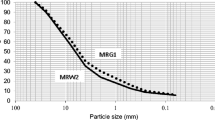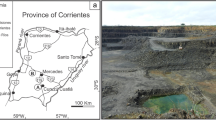Abstract
During the construction of the unbound pavement layers of Corridors X and XI in Serbia, a problem was detected regarding the evaluation of cleanliness of the available materials. The European standard for the sand equivalent from 1999 to 2015 had significant changes related to the test procedure. A mass correction has been taken into account. It consists of replacing a part of the fines with rinsed material (0.063/2 mm) when the percentage of fines exceeds 10% in a tested fraction. Thus, the test sample usually yields high values of the sand equivalent, which often exceeds the limits of 50% and 60%. From the standpoint of the technical specifications, aggregates are considered clean, while using other methods like methylene blue or a plasticity index, the presence of clay particles above the limits can be confirmed. This paper presents the results of research on 63 laboratory-prepared test samples of limestone aggregate with small quantities of the smectite group of clay minerals, where the fines content in the unbound aggregate, 0/31.5 mm, gradually increased up to 20%. It was found that the sand equivalent values are continuously decreasing from 84 to 14% in the fraction 0/2 mm and from 87 to 18% in the 0/4 mm fraction, with increasing of the methylene blue value of the all-in aggregate (MBA) from 0.4 to 4.5 g/kg. Correlations of different methods and fractions, as well as with the content of fines were found. There are no correlations with SE10 because of grouping the test data around one point.








Similar content being viewed by others
References
Bohar F (2008) Določitve metilen modro na značilnih kamenih agregatih - kaj pa zemljine? = determination of methylene blue on significant aggregates - what about soils? In: Discussions of the fifth consultation of Slovenian geotechnics. Slovenian Geotechnical Society, Nova Gorica, pp 105–114
Branco FC, Quinta-Ferreira M, Fernandes I (2017) Characteristics of aggregates used in road construction in Portugal, complying with the requirements of European Conformity (CE marking). Bull Eng Geol Environ 1–13. https://doi.org/10.1007/s10064-017-1066-8
Cvetanović A, Banić B (2007) Pavement. Academic Mind, Belgrade
Ćwiąkała M, Gajewska B, Kraszewski C, Rafalski L (2016) Recapitulation of research on frost susceptibility of unbound mixtures for pavement structures. Roads Bridg - Drog i Most 15. https://doi.org/10.7409/rabdim.016.018
FprEN 13242 (2018) European Standard emitted by CEN, European Committee for Standardization: Aggregates for unbound and hydraulically bound materials for use in civil engineering work and road construction. Technical Committee CEN/TC154 ‘Aggregates’
Mpalatsas I, Rigopoulos I, Tsikouras B, Hatzipanagiotou K (2013) Evaluation of cretaceous limestones from the Aitoloakarnania province (Western Greece) for their use as road aggregates in terms of their content in swelling clay minerals. Bull Geol Soc Greece 47:1991–1999
Nikolaides A, Manthos E, Sarafidou M (2007) Sand equivalent and methylene blue value of aggregates for highway engineering. Found Civ Environ Eng 10:111–121
Nikolić Ivanović M, Đokić O, Stefanović S, Milić B (2018) Fines quality for base and subbase layers in pavement. In: Third Serbian Road Congress. Serbian road society ‘Via - Vita’, Belgrade, p 1–9
Petkovšek A, Maček M, Pavšič P, Bohar F (2010) Fines characterization through the methylene blue and sand equivalent test: comparison with other experimental techniques and application of criteria to the aggregate quality assessment. Bull Eng Geol Environ 69:561–574. https://doi.org/10.1007/s10064-010-0274-2
Public Enterprise Roads of Serbia (2012) SRCS Technical Conditions for Roads Construction, 2 Special technical Conditions, 2.4 Pavement. Public Enterprise Roads of Serbia
SRPS EN 1097-1 (2013) European Standard emitted by CEN, European Committee for Standardization: Determination of the resistance to wear (micro-Deval). Technical Committee CEN/TC154 ‘Aggregates’
SRPS EN 1097-2 (2013) European Standard emitted by CEN, European Committee for Standardization: Methods for the determination of resistance to fragmentation. Technical Committee CEN/TC154 ‘Aggregates’
SRPS EN 933-1 (2013) European Standard emitted by CEN, European Committee for Standardization: Determination of particle size distribution — Sieving method. Technical Committee CEN/TC154 ‘Aggregates’
SRPS EN 933-8 (2008) European Standard emitted by CEN, European Committee for Standardization: Assessment of fines — Sand equivalent test. Technical Committee CEN/TC154 ‘Aggregates’
SRPS EN 933-8 (2013) European Standard emitted by CEN, European Committee for Standardization: Assessment of fines — Sand equivalent test. Technical Committee CEN/TC154 ‘Aggregates’
SRPS EN 933-8 (2016) European Standard emitted by CEN, European Committee for Standardization: Assessment of fines — Sand equivalent test. Technical Committee CEN/TC154 ‘Aggregates’
SRPS EN 933-9 (2014) European Standard emitted by CEN, European Committee for Standardization: Assessment of fines - Methylene blue test. Technical Committee CEN/TC154 ‘Aggregates’
SRPS EN 13285 (2012) European Standard emitted by CEN, European Committee for Standardization: Unbound mixtures — Specifications. Technical Committee CEN/TC 227 “Road materials”
SRPS U.B1.018 (2005) National Standard of Serbia: Testing of soils - Determination of particle size distribution. Institute for standardization of Serbia
Stapel EE, Verhoef PNW (1989) The use of the methylene blue adsorption test in assessing the quality of basaltic tuff rock aggregate. Eng Geol 26:233–246. https://doi.org/10.1016/0013-7952(89)90011-2
Stefanović S, Đokić O, Milić B (2014) Adjustment of the technical project requirements with the quality of available stone aggregate. In: First Serbian Road Congress. Serbian road society ‘Via - Vita’, Belgrade, pp 880–891
Tamer T (1996) The use of methylene blue adsorption test to assess the clay content of the Cappadocian tuff. https://www.mendeley.com/catalogue/methylene-blue-adsorption-test-assess-clay-content-cappadocian-tuff/
Acknowledgements
We are grateful to the Highway Institute Belgrade for funding part of the laboratory work. The Laboratory for Geomechanics for preparation of test samples and the Laboratory for Stone and Stone Aggregates for testing. The authors wish to thank the Faculty of Mining and Geology, Laboratory for Crystallography, for mineralogical analysis of selected samples and clay components. The authors also wish to thank Ivan Delević and Snezana Ninić for technical support.
Author information
Authors and Affiliations
Corresponding author
Rights and permissions
About this article
Cite this article
Đokić, O., Ivanović, M.N., Tošović, S. et al. Fines quality assessment in all-in aggregates for pavement layers related to different standard procedures. Bull Eng Geol Environ 78, 5483–5494 (2019). https://doi.org/10.1007/s10064-018-01435-5
Received:
Accepted:
Published:
Issue Date:
DOI: https://doi.org/10.1007/s10064-018-01435-5




